This article was co-authored by Luba Lee, FNP-BC, MS. Luba Lee, FNP-BC is a Board-Certified Family Nurse Practitioner (FNP) and educator in Tennessee with over a decade of clinical experience. Luba has certifications in Pediatric Advanced Life Support (PALS), Emergency Medicine, Advanced Cardiac Life Support (ACLS), Team Building, and Critical Care Nursing. She received her Master of Science in Nursing (MSN) from the University of Tennessee in 2006.
There are 8 references cited in this article, which can be found at the bottom of the page.
This article has been viewed 22,572 times.
CPAP devices and masks are some of the most effective ways to conquer sleep apnea and other associated sleep disorders. However, CPAP masks can be cumbersome and may take time to get used to wearing. They not only cause you discomfort, but change the way you sleep and may cause you some anxiety. Fortunately, by dealing with discomfort and anxiety, sleeping appropriately, and picking the right mask, you’ll be able to adjust to wearing your CPAP mask. In the end, you’ll get better sleep and be more rested in the morning.
Steps
Dealing with Discomfort or Anxiety
-
1Learn that adjusting to your mask will take time. The most important thing to know about adjusting to your CPAP mask is that it will take time. Ultimately, by wearing a mask, you’ll be changing the way you’ve slept for years. As a result, it will take you time to get used to the sensation of the mask and any changes that come with it.
- It may take weeks or months for you to feel “normal” with your mask on.
- The vast majority of people who wear CPAP masks report feeling discomfort during the first days or weeks of wearing them.
- Wearing a mask might come with a variety of changes, such as a new sleep position, a new pillow, and accepting the need for more space from your significant other.[1]
-
2Avoid feeling claustrophobic. A problem for many people adjusting to a CPAP mask is overcoming the feeling of claustrophobia – a condition in which you feel anxiety over being trapped or closed in. There are, though, some ways to get over the feeling of claustrophobia:
- Wear the mask in short increments at first. Try wearing it for 5 or 10 minutes when you are in bed.
- Slowly increase the amount of time you wear your mask until you’re so comfortable with it that you fall asleep with it on.
- Disconnect the mask from your machine and wear it around the house as you do housework or watch TV. This way, you’ll slowly grow used to wearing it.
- Consider a different style of mask that covers less of your face.[2]
Advertisement -
3Use white noise to help you relax. A great way to help you overcome anxiety associated with wearing a CPAP machine is to listen to white noise as you sleep. White noise is non-intrusive background noise that helps a lot of people overcome racing thoughts or other symptoms of anxiety.
- Rely on an alarm clock that generates white noise.
- Use your smartphone. There are a variety of apps you can download that will create white noise while you sleep.
- Try different types of white noise. Some people prefer the sound of a rainstorm, others prefer the sound of a babbling brook, while others prefer the sounds of a bustling city street.[3]
-
4Consult your doctor about medications. If you’ve experienced substantial anxiety or discomfort associated with wearing your CPAP mask, you should consult your doctor. Your doctor may be able to prescribe medication to help you adjust to your CPAP.
- Doctors have found that a short course of Lunesta may increase the efficacy of CPAP treatment.
- Depending on your unique health and situation, doctors may be able to prescribe anti-anxiety or anti-depression medications.
- Always consult your sleep specialist before beginning any medication.[4]
-
5Deal with a dry or stuffy nose. One unexpected problem that you may experience when adjusting to your CPAP mask is a dry or stuffy nose. This will certainly increase your discomfort and make the adjustment period more problematic.
- Consider a CPAP machine that also comes with a heated humidifier.
- Use 2–3 drops of nasal saline in each nostril before you go to bed to your nasal passages moist and healthy.
- Make sure your mask fits and is not leaky – this could cause you to have a dry nose.[5]
Sleeping Appropriately
-
1Lay in a safe and comfortable position. Perhaps the most important thing to sleeping with your CPAP is making sure you are laying so you can get restful sleep. Without laying in a comfortable way, the CPAP won’t be effective.
- The vast majority of CPAP users sleep either on the left or right side – the recommended sleeping position for people with CPAP masks.
- A minority of CPAP users sleep on their stomach or back – positions that are potentially dangerous or undermine the effectiveness of CPAP treatment.
- Back sleeping is also not very safe because your tongue may wind up obstructing your airway.[6]
-
2Use a special pillow if you need it. One thing you may want to try to help you sleep better with a CPAP mask is to use a special pillow. Using a special pillow or providing proper elevation will go a long way in helping you get more restful sleep, especially when you just first start to use a CPAP machine.
- Consider a CPAP-friendly pillow that has cutouts for your tube to fit into.
- If you are normally a back or stomach sleeper, you may want to consider a special pillow to help you adjust to side sleeping.
-
3Create a good environment for sleeping. A great way to ease your adjustment to wearing a CPAP mask is to create the best sleep environment possible. By creating a good sleeping environment, you’ll help set yourself at ease, increase your chances of getting restful sleep, and help smooth the transition of your adjustment time. Try to relax before you go to sleep and only go to bed when you feel tired.
- Purchase new sheets and blankets if that will make you more comfortable.
- Turn on the fan or turn down the air conditioning if you like it cooler while you sleep.
- Consider buying a new bed if your old bed is worn out or no longer comfortable.[7]
- Taking a warm bath can help you feel more relaxed before going to bed.
- Avoid caffeine or alcohol before bedtime since it can affect how well you sleep.[8]
Picking the Right Mask
-
1Consult a sleep specialist. To adjust to wearing a CPAP mask, you need to be under the care of a sleep specialist. This is important, as many general practitioners may not have the experience or expertise needed to guide a patient through the problems associated with CPAP treatment.
- Seek a referral to a sleep specialist from your primary care physician.
- Maintain contact with the sleep specialist as you are adjusting to your CPAP mask.
- Make sure all doctors you seek treatment from are aware of your sleep apnea diagnosis and the fact that you use a CPAP mask.[9]
-
2Choose your mask style. There are a wide variety of CPAP masks available. As a result, you should spend a little time making sure you pick a mask and style that work for you. By not doing this, you may be stuck with a mask that is much harder to adjust to. Consider:
- Full face masks that go over your nose and mouth. This is the style that will likely stay on your face better while you sleep.
- Nasal pillows that cover your nostrils.
- Half masks that cover your nose.
- Specially designed masks that are custom made to fit your face.[10]
-
3Purchase the right size mask. Your mask size is also very important in making sure your mask fits properly. Without a mask that is the right size, you’ll have a tough time adjusting to wearing your mask.
- Sizes vary based on the brand and style of mask. Don’t expect that the size of one mask will correspond to the size of another. Always make sure to have a proper fitting.
- Familiarize yourself with ways of adjusting your mask to fit the best. Many masks offer a variety of ways to adjust tightness and fit.
- Contact your doctor if your mask does not fit.
- Follow directions when securing your mask.[11]
References
- ↑ http://www.webmd.com/sleep-disorders/sleep-apnea/features/cpap-machine#1
- ↑ http://www.mayoclinic.org/diseases-conditions/sleep-apnea/in-depth/cpap/art-20044164
- ↑ http://journals.lww.com/ejanaesthesiology/Fulltext/2010/06121/The_effects_of_music,_white_noise_and_operating.428.aspx
- ↑ https://www.sciencedaily.com/releases/2009/05/090517143233.htm
- ↑ http://www.mayoclinic.org/diseases-conditions/sleep-apnea/in-depth/cpap/art-20044164
- ↑ http://www.cpap.com/DisplayNewsletter/CPAP-SLEEP-POSITIONS-2015
- ↑ https://sleepfoundation.org/sleep-news/six-tips-design-the-ideal-bedroom-sleep
- ↑ https://www.mayoclinic.org/diseases-conditions/sleep-apnea/in-depth/cpap/art-20044164
- ↑ http://www.aafp.org/afp/2004/0201/p561.html
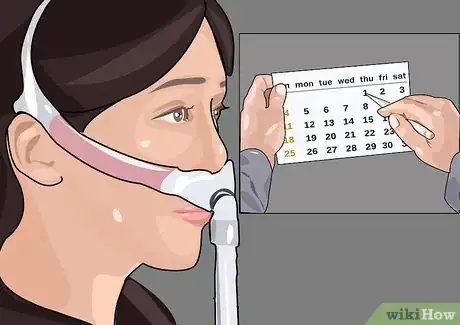
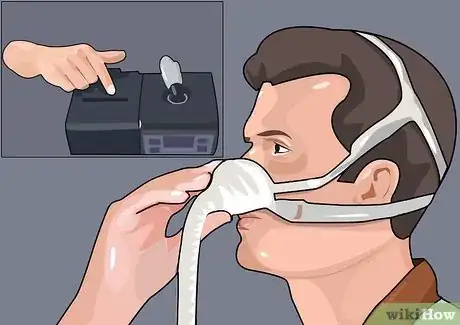




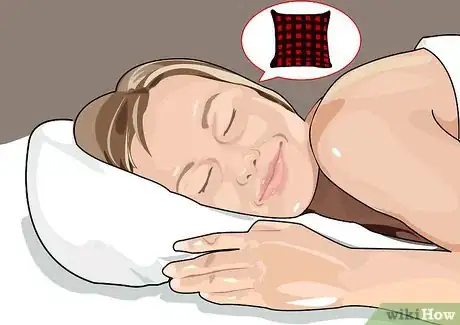
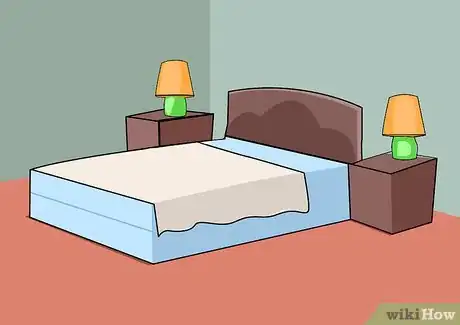

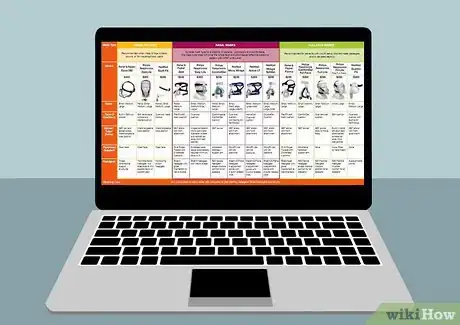



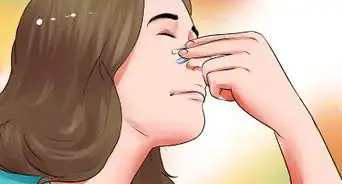






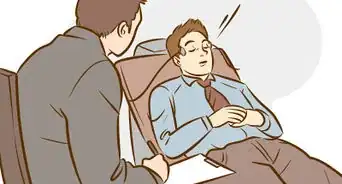

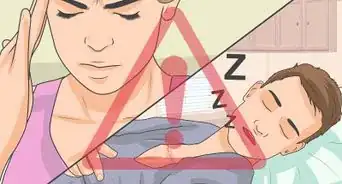










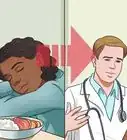
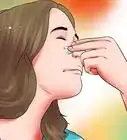





































Medical Disclaimer
The content of this article is not intended to be a substitute for professional medical advice, examination, diagnosis, or treatment. You should always contact your doctor or other qualified healthcare professional before starting, changing, or stopping any kind of health treatment.
Read More...